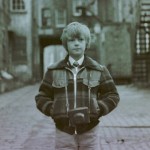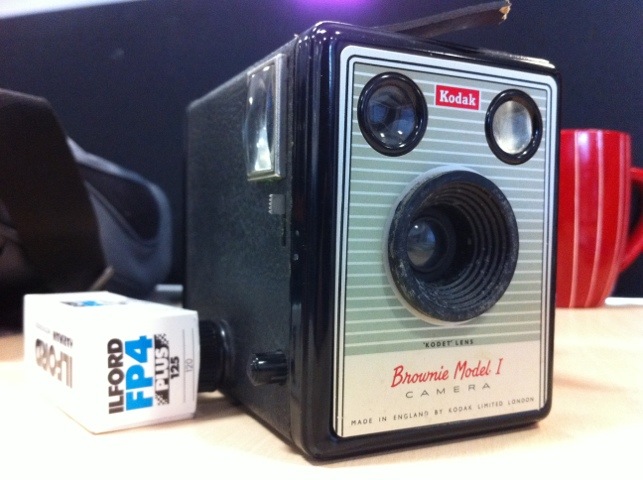 When I was 7 I bought myself a film camera from Wakefield fleamarket – a Halina 35mm camera purchased for £1. I took it all over the place and went through the first couple of films like mad (mostly taking photographs of the sky or the floor because I couldn’t get the hang of the viewfinder). My father was processing film at the time and started loading the occasional spool of B&W in and that’s how I started out in photography… once we’d moved to a larger house he took over the cellar and we did prints too.
When I was 7 I bought myself a film camera from Wakefield fleamarket – a Halina 35mm camera purchased for £1. I took it all over the place and went through the first couple of films like mad (mostly taking photographs of the sky or the floor because I couldn’t get the hang of the viewfinder). My father was processing film at the time and started loading the occasional spool of B&W in and that’s how I started out in photography… once we’d moved to a larger house he took over the cellar and we did prints too.
Almost 30 years later I’m using digital for my semi-professional work: I carry various Canon pro digital bodies around and a complement of lenses (a partial kit-list is on my Flickr profile), and I post-process using Lightroom on the Mac. An average gig shoot for me results in about 200 photos per act and I pare those down into about 40 or 50 shots for a client, all of which is a far cry from 24 frames on film.
I recently did a contract in Halifax (good lord deliver me) as part of my dayjob. Lunchtime wanderings uncovered a camera shop near the market (Janet Green Photographic, I’d link to a website but they don’t have one) where there was a window full of second-hand photographic kit – everything from mid-1950s medium-format bodies up to low-end digital, and so a germ of an idea formed – get an old film camera and learn to develop my own photos again. I pressed my nose to the glass almost daily in the hope that a suitable camera would be on display. Christmas drew closer, the end of the contract loomed, but less than 2 weeks before I’d be out of the area one appeared in the window for just £29: a Canon EOS 500N, one of the more recent 135 Canon range. I bimbled in and after verifying it would accept my Canon EF lenses I walked out as the proud owner of a film camera body, some chemicals and a few spools of Ilford FP4+ film.
The first thing I noticed was that I was conscious how many photos I wasn’t taking using film. I assumed I’d go through film like wildfire but it took me the best part of 3 days to blow my first 24-exposure film (the second film took a little less time principally because I was out in sunny Halifax getting some gritty industrial images :)). This did make me realise that although I scattergun at gigs I am more inclined to take time to set up a shot elsewhere.
Once home and in the kitchen I mixed up some developer and spent 20 minutes lightproofing the understair cupboard. Every last LED from the wireless base-station, burglar alarm, central heating system got double helpings of gaffer-tape. Hallway lights went off, the cracks around the door stuffed with scarves. Total darkness, hooray. I turned the safelight on, loaded the film into the canister and went off to develop it.
Right. Safelight. Yeah – about that: there’s no safelight for film… I’d forgotten that bit and overexposed it. I had also been using a dodgy thermometer, not that it would have made much difference. The second time I was a lot more careful and some success ensued, having processed a spool of Ilford HP4+ (ISO400) in Ilfosol-3 developer: this resulted in quite a chunky grain. Still, not bad considering I’ve been trying to remember how to do it all based upon vague memories of watching Dad.
As a sidenote: I haven’t been doing any printing, instead using a slide scanner from Maplin to throw the negatives into JPEG files; it’s only a cheap thing with a lamp which shines the slide onto a small CCD and auto-compensates for exposure etc. – the results aren’t very good. This one will do for the moment as long as I put the images through Lightroom, at least until I find a USB slide scanner I’m happy with.
Subsequently I walked into Halifax and blew off a spool of Ilford FP4+ (ISO100). I haven’t tried pushing the film yet, I’m taking baby-steps and since Christmas I’ve been using it as an occasional ‘grab camera’ to play with rather than anything serious.
Most of my supplies are coming from Amazon marketplace sellers (RK Photographic are sending me most of it including a black bag, a load of FP4+ and a film spool opener). Locally Dale Photographic in Leeds sells chemicals and film which is useful in an emergency and if anyone wants to buy me a present they have a secondhand Hasselblad MF 6×6 120-roll camera with a couple of lenses for £1500… thought not!
Tonight though the 500N gets a proper run at a gig using Ilford Delta 3200 film (ISO3200) which I will probably process using Microphen developer later on in the week. I’m hoping to replicate some of the more iconic Kev Cummins film shots from the early 80s – somehow doing colour-to-B&W in Lightroom feels like cheating and I’m hopeful of good results. At least I don’t have to worry about red/yellow saturation 😉
(The photo is me aged 8 with the Halina – my Dad took it when we went on a photowalk in Wakefield; the courtyard is round the back of the old Post Office, and it’s now known as ‘The Latin Quarter’.)
Update: Julian (aka @liquidsquid on Twitter) said that this was his idea. If I’m going to be perfectly honest it was discussions with quite a few folks which led to this, not least @leica0000, @john2755 and my landlady in Milton Keynes towards the end of last year who gave me a box full of old Patterson developing kit. That said, the Delta3200 was definitely Julian’s idea.



